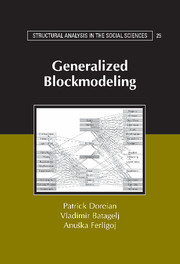Book contents
- Frontmatter
- Contents
- Preface
- 1 Social Networks and Blockmodels
- 2 Network Data Sets
- 3 Mathematical Prelude
- 4 Relations and Graphs for Network Analysis
- 5 Clustering Approaches
- 6 Optimizational Approach to Conventional Blockmodeling
- 7 Foundations for Generalized Blockmodeling
- 8 Blockmodeling Two-Mode Network Data
- 9 Semirings and Lattices
- 10 Balance Theory and Blockmodeling Signed Networks
- 11 Symmetric–Acyclic Blockmodels
- 12 Extending Generalized Blockmodeling
- Bibliography
- Author Index
- Subject Index
- Titles in the series
4 - Relations and Graphs for Network Analysis
Published online by Cambridge University Press: 13 January 2010
- Frontmatter
- Contents
- Preface
- 1 Social Networks and Blockmodels
- 2 Network Data Sets
- 3 Mathematical Prelude
- 4 Relations and Graphs for Network Analysis
- 5 Clustering Approaches
- 6 Optimizational Approach to Conventional Blockmodeling
- 7 Foundations for Generalized Blockmodeling
- 8 Blockmodeling Two-Mode Network Data
- 9 Semirings and Lattices
- 10 Balance Theory and Blockmodeling Signed Networks
- 11 Symmetric–Acyclic Blockmodels
- 12 Extending Generalized Blockmodeling
- Bibliography
- Author Index
- Subject Index
- Titles in the series
Summary
In this chapter we continue our presentation of a series of mathematical concepts that provide a deeper understanding of blockmodeling ideas. Our goal is to lay the foundations for a discussion of both conventional blockmodeling (in Chapter 6) and our generalized approach to partitioning social networks (in Chapters 6–11).
The main topics in this chapter are a more detailed discussion of graphs (Section 4.1), a presentation of some types of binary relations (Section 4.2), and some basic ideas of partitions and equivalence relations (Section 4.3). The first two sections build toward Section 4.3, which considers ideas at the core of blockmodeling. We consider acyclic relations (Section 4.4), a topic used later in this chapter and in Chapter 11. This is followed by materials on orders (Section 4.5) and a short statement about networks (Section 4.6) using materials developed in this chapter. Centrality (Section 4.7) is the last topic considered in this chapter. We do not deal with graph or network centralization, for it is not used in our discussion of blockmodeling.
GRAPHS
Graphs allow us to describe many social network situations very precisely. We provided a preliminary – and intuitive – discussion of graphs in Chapter 1, where we used a variety of examples. In this section, we take a more formal approach to graphs. Binary relations, as noted in Section 3.2, are closely related to graphs and provide our point of departure.
- Type
- Chapter
- Information
- Generalized Blockmodeling , pp. 94 - 132Publisher: Cambridge University PressPrint publication year: 2004



